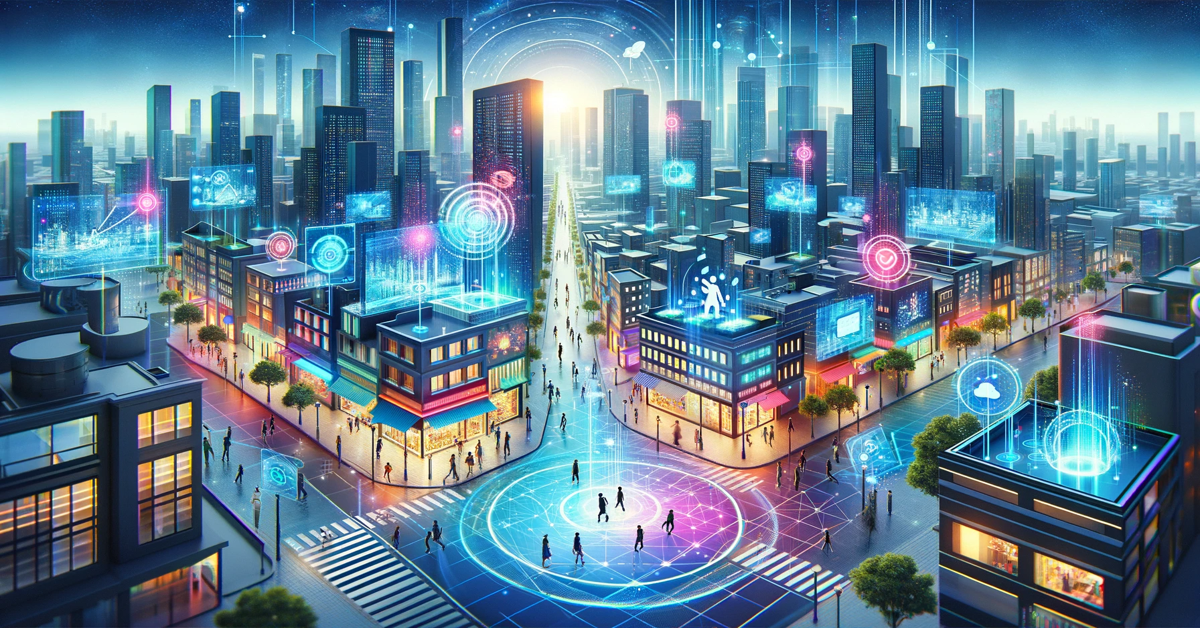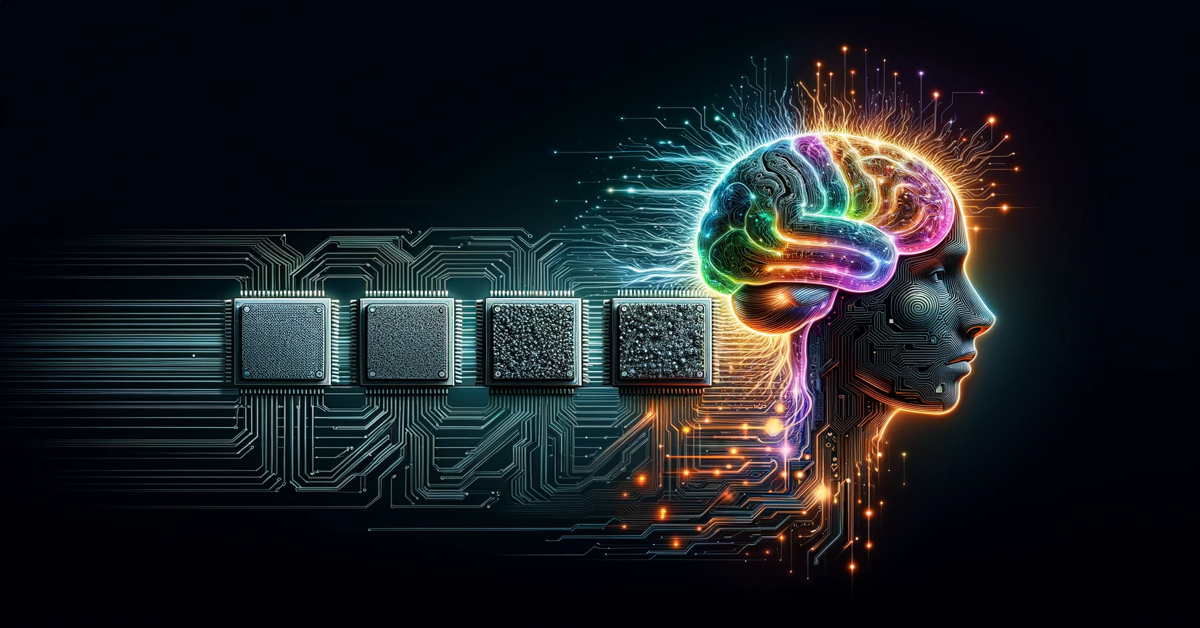
What happens when embedded intelligence is everywhere?
Imagine a physical and digital world that is continuously customizing itself to meet your preferences—a world that is “automagical.”
What will this feel and look like?
For example, enter any room and the lighting, music, and temperature are adjusted to your needs. Or enter a store to shop for an item, or a restaurant to get your favorite meal, and if you have “self-ID” turned on, the store’s AI knows who you are and what you’re looking for, having it ready to save you time.
Come home after a stressful day at work, and your preferred drink is waiting for you while your favorite comedian is playing on your wall screen.
Your home, car and office are continuously monitoring your health vitals. And should you want to learn a new language (though instantaneous translation is now available almost everywhere), your home AI will prompt you in the language of your choice, offering helpful hints in English where needed.
Over the next two blogs in this series, as we continue to explore this AI Metatrend, we’ll look at examples of embedded intelligence across several industries.
Today, we’ll cover examples in the fast food and retail industries.
Let’s dive in...
NOTE: If you want to better understand AI and how to use the technology to go big, create wealth, and increase your impact on the world… then join me at my upcoming Abundance360 Summit in March.
Fast Food Chains are Incorporating AI into Their Ordering Processes
According to a survey of global customer service leaders conducted by Boston Consulting Group, 95% expect their customers to be served by an AI bot at some point in their customer service interactions by 2025.
This is particularly true in the fast-food industry, where companies are deploying AI-powered chatbots to take drive-through orders, which represent up to 70% of annual sales for fast food restaurants.
For example, imagine pulling up to a Popeye’s drive-through window and you're greeted by Tori's cheerful digital voice. "Welcome! How can I assist you today?" Intrigued by the flawless, human-like interaction, you place a complex order, testing the limits. Without missing a beat, Tori suggests a drink to complement your meal, its recommendation based on popular pairings. As you pull away, your order in hand and the exact drink you didn’t know you craved, you can't help but marvel. The accuracy, the efficiency, the uncanny ability to predict your tastes—this isn't just fast food; it's the future served hot and fresh.
This is already happening.
A Popeye’s restaurant in Louisiana reported that after launching its chatbot called “Tori” to handle drive-through orders, speed of service increased by 20%, drink sales went up by 150%, and customer satisfaction improved by 20%. This was all done with 99% accuracy in taking customers’ orders.
Welcome to the AI-powered dining experience.
And Popeye’s is not alone. Fast food chains from McDonald’s and Domino’s to Taco Bell and Wingstop are experimenting with AI-powered voice assistants and chatbots to automate processes and improve efficiencies.
Chipotle, for instance, opened its first AI-powered “Chipotlane,” a drive-through lane for mobile orders, back in 2018. When the company announced its 500th Chipotlane in September 2022, it said that the automated mobile pickup lanes generate higher volumes and greater returns than its traditional stores. Chipotle has stated that 80% of the new restaurants it plans to open in 2024 will have Chipotlanes.
And in May 2023, Wendy’s announced that it will be rolling out its new AI chatbot, “FreshAI,” which it developed in partnership with Google. Sales from drive-throughs account for 75% to 80% of the company’s orders. FreshAI will initially be rolled out at a few stores in Ohio, where it will give customers a better ordering experience by reducing errors and miscommunication.
As Kevin Vasconi, the company’s Chief Information Officer, said in a statement: “It’s at least as good as our best customer service representative, and it’s probably on average better.”
CEO Todd Penegor added, “You won’t know you’re talking to anybody but an employee.”
Walmart’s Embedded AI Improves Everything from Supply Chain Management to Fitting Room Tech
The world’s largest retailer, Walmart, is using embedded AI across the company to improve both the company’s operations and the customer experience.
For instance, Walmart has large language models (LLMs) like GPT-4 to create nearly two dozen different experiences that use the platforms for natural language understanding capabilities. This includes a chatbot that 1 million Walmart associates interact with for customer care.
In an interview with VentureBeat in April 2023, Desirée Gosby, Vice President of Emerging Technology at Walmart Global Tech, said generative AI “will be as big a shift as mobile, in terms of how our customers are going to expect to interact with us.”
Here are four distinct ways Walmart is using AI:
First, in improving its global supply chain. Over the next few years, Walmart will launch 4 next-generation fulfillment centers that will use machine learning and robotics to speed up the fulfillment process further. When combined with its traditional fulfillment centers, the company will be able to reach 95% of the U.S. population with next-day or two-day shipping.
AI has allowed Walmart to move from simply predicting sales demand (i.e., how much will sell that is already in the stores) to predicting consumer demand (i.e., what customers will actually want to buy) through analyzing data across channels: from Google searches to TikTok feeds.
Second will be the deployment of AI-powered fitting room tech. Imagine Walmart’s dynamic virtual fitting room, which will allow customers to shop for clothes online and see how a given item will actually look on them. The company’s “Choose My Model" experience offers customers a choice of 50 models between 5’2” – 6’0” in height and sizes XS – XXXL. This allows customers to choose a model who best represents their height, body shape, and skin tone.
Eventually, such generic body models will be replaced by your own detailed avatar—derived from a high-resolution body and facial scan of the type already available today. Imagine having the AI system spin up a fashion show with 30 copies of your avatar walking down the runway modeling 30 different outfits for your selection.
Third is the deployment of conversational AI in customer interactions. Walmart’s “Text to Shop” technology is powered by GPT-4 and allows customers to text or say what they want and have the item automatically added to their cart. The digital shopping assistant platform leverages departments across the company, including Customer Care, and runs on both Google and Siri.
Eventually, the conversational AI offered up will be a branded fashion consultant. Imagine speaking in natural language to Walmart’s GQ or Vogue fashion consultant in which you explain the event your planning to attend (a barbecue, a wedding, etc.), offer up your budget range, and express the feeling you’re trying to achieve with your new purchase. The AI agent then generates a customized fashion show of clothing meeting your description. Thirty runway models that look just like you, are showing off 30 different outfits for your viewing and shopping pleasure.
Fourth and finally, Walmart chatbots will be used to negotiate with its suppliers. The retailer is using an AI-powered chatbot developed by Pactum, a California-based company that specializes in autonomous negotiation software. The chatbot, called “Pactum AI,” works by taking into account information on Walmart’s product needs and budget and then it communicates with human sellers to get Walmart the best possible deal.
Walmart has saved an average of 3% on the contracts that have been negotiated by the chatbot. At the same time, Bloomberg reports 3 out of 4 suppliers have told Walmart that they prefer to negotiate with an AI instead of a human!
Why This Matters
This is a world of “surprise and delight.”
And it’s not science fiction—it’s a reality racing towards all of us in the decade ahead.
While this world is not here yet, the above examples show what’s possible even today.
The question remains: What role will YOU play in this unfolding narrative?
In the next blog covering this AI Metatrend, we’ll look at how embedded intelligence is currently being deployed in two industries that I believe are most ripe for disruption: education and healthcare.
I wanted to take a second to tell you about a company I'm personally invested in and that is a part of my personal health optimization: Seed Health, a microbiome science company that is doing incredible research (which you’ll hear more about from me and on the podcast in the coming months). Seed is most known for their innovations and clinical research in probiotics—especially DS-01®, which I take and believe is the best probiotic available.
Unlike our genome, our gut microbiome is one of the most important levers of health given its connectivity to almost every biological function and organ system. How can you optimize your gut health? In addition to diet and other lifestyle choices, here’s what I do:
Every day, I take two capsules of Seed’s DS-01® Daily Synbiotic: a broad spectrum 2-in-1 probiotic and prebiotic formulated with 24 genetically distinct clinically- and scientifically-studied probiotic strains and a polyphenol-based prebiotic.
Developed from a deep understanding of the complex interactions within the microbiome, DS-01® confers benefits in and beyond the gut. This novel synbiotic preserves ecosystem function, fortifies the gut barrier, promotes healthy regularity, reinforces an optimal gut-skin axis, promotes cardiovascular health, and supports healthy immunological responses in the GI tract.
The specific prebiotic is sourced from the skin of Indian pomegranate and has also been clinically validated to support healthy aging, including the reduction of aging markers like the appearance of wrinkles. Unlike most fiber-based prebiotics, Seed’s is non-fermenting which makes it gentler on the stomach and tolerable for a FODMAP diet.
In contrast with most probiotics, DS-01® is engineered to survive with Seed’s patented capsule-in-capsule ViaCap® technology that optimizes viability and delivers a precision release to the colon, where it matters most. This technology also ensures stability, so there’s no refrigeration required.
Known for their renowned scientists in the field of microbiome and probiotics, Seed’s scientific rigor and ongoing research have set them apart from others. DS-01® strains have been clinically studied in over 20 clinical and mechanistic studies. Two clinical trials evaluating the DS-01® formulation have recently been completed: one assessing the impact of DS-01® on patients with Irritable Bowel Syndrome (IBS) under Investigational New Drug authorization from the FDA; and another evaluating the effects of DS-01® on the gut microbiota during and after antibiotic usage (under Health Canada authorization). This new data is anticipated to be published in high-impact scientific journals in the coming six months.
I value Seed's scientific rigor and the company's work. This is why I believe DS-01® is so effective and has become the probiotic of choice not just for me, but for so many other people I respect.
As part of my mission to help my community optimize their health, we’ve worked with Seed to create a code for our readers. Use code PETER25 for 25% off your first month of Seed’s DS-01®.
Learn More About Seed's DS-01®
I discuss how technology will create a world of abundance on my podcast. Here’s a conversation I recently enjoyed:
A Statement From Peter:
My goal with this newsletter is to inspire leaders to play BIG. If that’s you, thank you for being here. If you know someone who can use this, please share it. Together, we can uplift humanity.
Topics: Abundance Entrepreneurship Abundance 360








